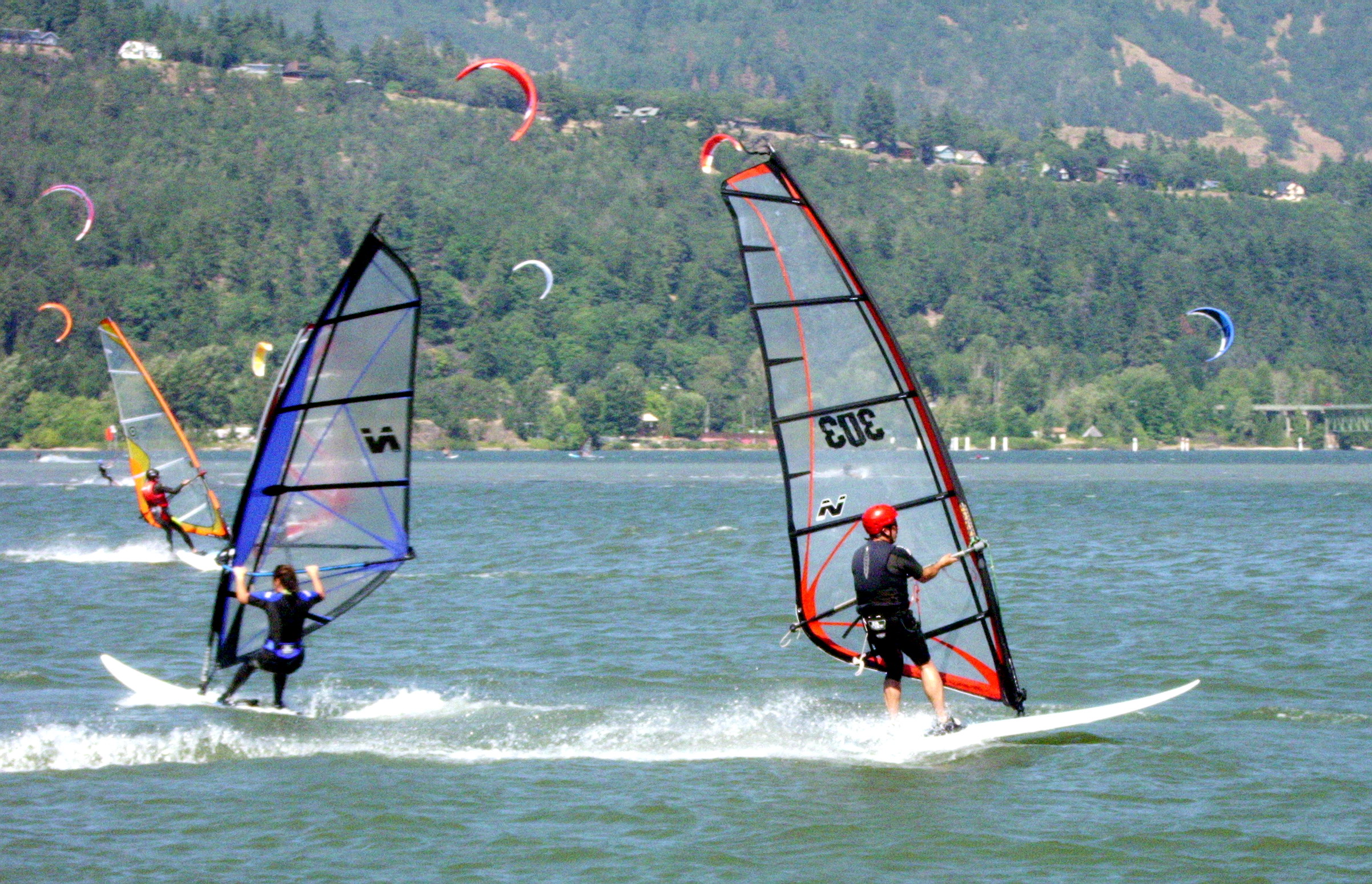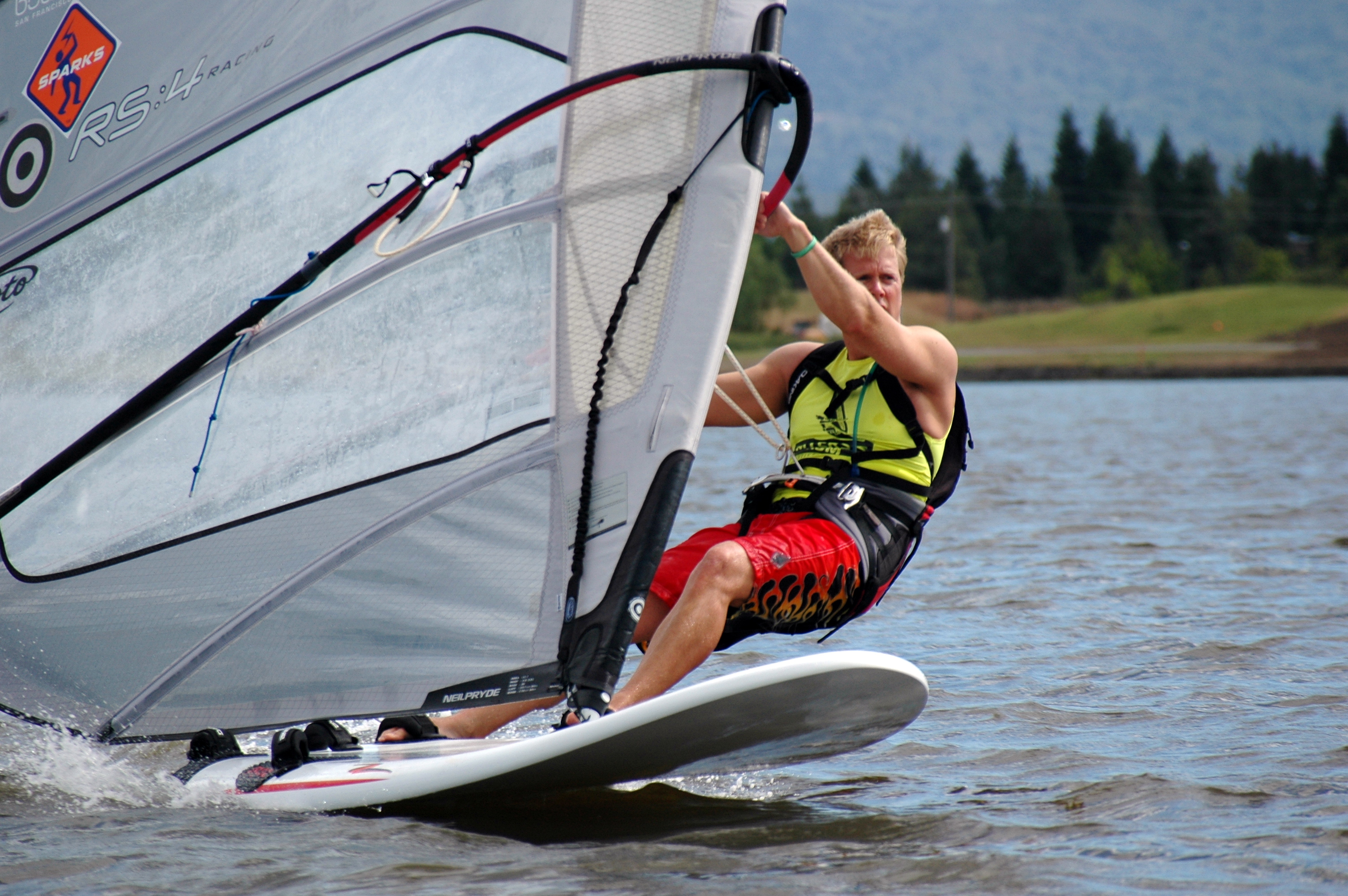|
Windsurfing
Windsurfing is a wind-propelled water sport that is a combination of sailing and surfing. It is also referred to as "sailboarding" and "boardsailing", and emerged in the late 1960s from the Californian aerospace and surf culture. Windsurfing gained a popular following across Europe and North America by the late 1970s and had achieved significant global popularity by the 1980s. Windsurfing became an Olympic sport in 1984. History Newman Darby of Pennsylvania created a rudderless "sailboard" in 1964 that incorporated a pivoting square rigged, "square rigged" or "kite rigged" sail which allowed the rider to steer a rectangular board by tilting the sail forward and back. Darby's design however had notable performance limitations. Unlike the modern windsurfer design, Darby's sailboard was operated "back winded", with the sailor's back to the lee side of a kite-shaped sail. This much less efficient and less desirable sailing position is opposite of how a modern windsurfer is operated. ... [...More Info...] [...Related Items...] OR: [Wikipedia] [Google] [Baidu] |
Jim Drake (engineer)
Jim Drake (1929 – 2012) was an American aeronautics, aeronautical engineer who is widely credited with the invention of the sport of Windsurfing. He patented his windsurfing concept in 1968. Drake conceptualized, designed and hand built the first board and articulating sail rig prototype in his garage. He started the sport's first company, Windsurfing International. He produced multiple championship winning windsurfing board designs throughout his career, as well as created a popular offshoot of windsurfing with the world's first un-masted Wing foiling, wing sail. Drake would go on to become an altruistic figure head for the sport he pioneered over the course of his lifetime. Aeronautics career Drake earned a bachelor's degree in mechanical engineering with an option in aeronautics from Stanford university in 1951. He began his aeronautical engineering career at North American Aviation in his hometown of Los Angeles, California. There he worked in the advanced design group as a ... [...More Info...] [...Related Items...] OR: [Wikipedia] [Google] [Baidu] |
Formula Windsurfing
Formula Windsurfing is the high-performance, competitive course-racing format of the windsurfing world. This type of sailing boards enjoy a massive wind range that enables racing in winds from 7 to 35 knots, and are capable of reaching speeds of over 30 knots. History and beginnings This class of windsurfing was born in the late 1990s as an upgrade from funboard-type course-racing boards looking to lower wind limits, broaden wind strengths and reduce racing costs with a limited quiver. Historically, board designers used to increase the length and volume of the boards in order to allow for sailing in lighter winds, but during the late 1990s, some brands like AHD, Berky, Drops, ML, Pro-Tech, Roberts and Starboard started to work on alternative solutions. They came up with designs that widened and shortened the board length whilst retaining high volume, and used larger fins to get into planing earlier. They also moved the fins further back, which prompted newer concepts with diff ... [...More Info...] [...Related Items...] OR: [Wikipedia] [Google] [Baidu] |
Newman Darby
Sidney Newman Darby Jr. (January 31, 1928 – December 3, 2016) was an American inventor best known as the inventor of the sailboard. Biography He was born in 1928 and grew up in Wilkes-Barre, Pennsylvania and began building boats when he was 12. His first boat sank, but he fished it out of the Susquehanna River, near his home, and made it into a home for snakes. Darby and his wife made their home in Saint Johns, Florida, where he died on December 3, 2016, at the age of 88. Sailboard Darby is known and recognized by some as the first person to develop an early version of the sailboard. He had applied for a patent but due to cost he gave up on patenting. He developed the early craft and marketed it nationally, selling a hundred boards. Darby first conceived of a hand-operated square sail attached to a catamaran in 1948, when he was 20. In the mid-1960s, Darby conceived the "Darby Sailboard": a hand-held square rigged "kite" sail on a floating platform for recreational use. The cr ... [...More Info...] [...Related Items...] OR: [Wikipedia] [Google] [Baidu] |
Peter Chilvers
Peter Chilvers was an inventor, engineer and promoter of sailing and windsurfing. He is credited with an early version of a sail powered surfboard. He died from lung cancer on 26 February 2015. Life Chilvers had been an engineer for Lotus and founded a sailing and windsurfing centre in London. Chilvers is credited with creating a crude sailing craft propelled by a free-sail system while living on Hayling Island in 1958. His craft was recognized as prior art in later court cases in England regarding sailboard patents and royalties. The windsurfing centre in London's East End was founded by Chilvers as a philanthropic venture to promote sailing and windsurfing amongst underprivileged children of the East End in the 1970s. He created and maintained the centre for over 25 years. Peter was certainly still running the sailing centre together with a bar on a Dutch sailing barge at Royal Victoria Dock into the 2000s. He also used to park his very distinctive prototype short wheelbase ... [...More Info...] [...Related Items...] OR: [Wikipedia] [Google] [Baidu] |
IQFoil
iQFoil is a windsurfing class selected by World Sailing to replace the RS:X for the 2024 Summer Olympics. The discipline has similarities to Formula Windsurfing, however a notable difference is that sailors only use one sail. The sail size was originally 9 m2 for the men and 8 m2 for the women. The rider has a choice between using a Sailing hydrofoil, hydrofoil or a conventional 68 cm fin. Equipment Evolution Starting in January 2025 there are equipment changes: * Men will switch from the 9 m2 sail to an 8 m2 (previous Female and Youth design) sail. * Female and Female Youth change from the 8 m2 sail to a new design 7.3 m2 sail. * Both categories adopt the existing 4.90 m mast to align with the revised sail sizes. Events World Championships * iQFoil World Championships * iQFoil Youth World Championships * Youth Sailing World Championships Olympics * Sailing at the 2024 Summer Olympics – Men's iQFoil * Sailing at the 2024 Summe ... [...More Info...] [...Related Items...] OR: [Wikipedia] [Google] [Baidu] |
Sailing
Sailing employs the wind—acting on sails, wingsails or kites—to propel a craft on the surface of the ''water'' (sailing ship, sailboat, raft, Windsurfing, windsurfer, or Kitesurfing, kitesurfer), on ''ice'' (iceboat) or on ''land'' (Land sailing, land yacht) over a chosen Course (navigation), course, which is often part of a larger plan of navigation. From prehistory until the second half of the 19th century, sailing craft were the primary means of maritime trade and transportation; exploration across the seas and oceans was reliant on sail for anything other than the shortest distances. Naval power in this period used sail to varying degrees depending on the current technology, culminating in the gun-armed sailing warships of the Age of Sail. Sail was slowly replaced by steam as the method of propulsion for ships over the latter part of the 19th century – seeing a gradual improvement in the technology of steam through a number of developmental steps. Steam allowed schedul ... [...More Info...] [...Related Items...] OR: [Wikipedia] [Google] [Baidu] |
Planing (sailing)
Planing ( ) is the mode of operation for a waterborne craft in which its weight is predominantly supported by lift (force), hydrodynamic lift, rather than Hydrostatics, hydrostatic lift (buoyancy). Many forms of marine transport make use of planing, including High-speed craft, fast ferries, racing boats, seaplanes, and water skis. Most surfboards are planing or semi-planing hulls. Beyond planing, fast vessel designs have seen a transition to hydrofoil designs. History The earliest documented planing sailboat was a proa built in 1898 by Commodore Ralph Munroe#Vessels designed, Ralph Munroe. It was capable of speeds of more than twice the hull speed. Planing a sailing Dinghy sailing, dinghy was first popularised by Uffa Fox in Britain. In 1928 Fox introduced planing to the racing world in his International 14 dinghy, ''Avenger''. That year he gained 52 first places, 2 seconds, and 3 third places out of 57 race starts. This performance was noticed by other designers who further ... [...More Info...] [...Related Items...] OR: [Wikipedia] [Google] [Baidu] |
Sail
A sail is a tensile structure, which is made from fabric or other membrane materials, that uses wind power to propel sailing craft, including sailing ships, sailboats, windsurfers, ice boats, and even sail-powered land vehicles. Sails may be made from a combination of woven materials—including canvas or polyester cloth, laminated membranes or bonded filaments, usually in a three- or four-sided shape. A sail provides propulsive force via a combination of lift and drag, depending on its angle of attack, its angle with respect to the apparent wind. Apparent wind is the air velocity experienced on the moving craft and is the combined effect of the true wind velocity with the velocity of the sailing craft. Angle of attack is often constrained by the sailing craft's orientation to the wind or point of sail. On points of sail where it is possible to align the leading edge of the sail with the apparent wind, the sail may act as an airfoil, generating propulsive force as air pa ... [...More Info...] [...Related Items...] OR: [Wikipedia] [Google] [Baidu] |
Epoxy
Epoxy is the family of basic components or Curing (chemistry), cured end products of epoxy Resin, resins. Epoxy resins, also known as polyepoxides, are a class of reactive prepolymers and polymers which contain epoxide groups. The epoxide functional group is also collectively called ''epoxy''. The IUPAC name for an epoxide group is an oxirane. Epoxy resins may be reacted (cross-linked) either with themselves through catalytic homopolymerisation, or with a wide range of co-reactants including polyfunctional amines, acids (and acid anhydrides), phenols, alcohols and thiols (sometimes called mercaptans). These co-reactants are often referred to as hardeners or curatives, and the cross-linking reaction is commonly referred to as Curing (chemistry), curing. Reaction of polyepoxides with themselves or with polyfunctional hardeners forms a thermosetting polymer, often with favorable mechanical properties and high thermal and chemical resistance. Epoxy has a wide range of application ... [...More Info...] [...Related Items...] OR: [Wikipedia] [Google] [Baidu] |
Plywood
Plywood is a composite material manufactured from thin layers, or "plies", of wood veneer that have been stacked and glued together. It is an engineered wood from the family of manufactured boards, which include plywood, medium-density fibreboard (MDF), oriented strand board (OSB), and particle board (or chipboard). All plywoods bind resin and wood fibre sheets (cellulose cells are long, strong and thin) to form a composite material. The sheets of wood are stacked such that each layer has its grain set typically (see below) perpendicular to its adjacent layers. This alternation of the grain is called ''cross-graining'' and has several important benefits: it reduces the tendency of wood to split when nailed at the edges; it reduces thickness swelling and shrinkage, providing improved dimensional stability; and it makes the strength of the panel consistent across all directions. There is usually an odd number of plies, so that the sheet is balanced, that is, the surface layers ha ... [...More Info...] [...Related Items...] OR: [Wikipedia] [Google] [Baidu] |
Hood River Windsurfers 20060701 0759
Hood may refer to: Covering Apparel * Hood (headgear), type of head covering ** Article of academic dress ** Bondage hood, sex toy * Hoodie, hooded sweatshirt Anatomy * Clitoral hood, a hood of skin surrounding the clitoris * Hood, a flap of skin behind the head of a cobra Other coverings * Fume hood, piece of laboratory safety equipment * Hood (car), covering over the engine compartment in a motor vehicle ('bonnet' in most Commonwealth countries) * Kitchen hood, exhaust system for a stove or cooktop * Lens hood, device used to block light from creating glare in photographs Rail transport uses * Hood (rail transport), a rigid cover to protect a load on a flat wagon or a coil car * Hood unit, a type of diesel or electric locomotive ** Long hood ** Short hood Art, entertainment and media Fictional entities * The Hood, fictional Marvel Comics character * Hood (Malazan), fictional god in the ''Malazan Book of the Fallen'' universe * Hood (''Thunderbirds''), fiction ... [...More Info...] [...Related Items...] OR: [Wikipedia] [Google] [Baidu] |






